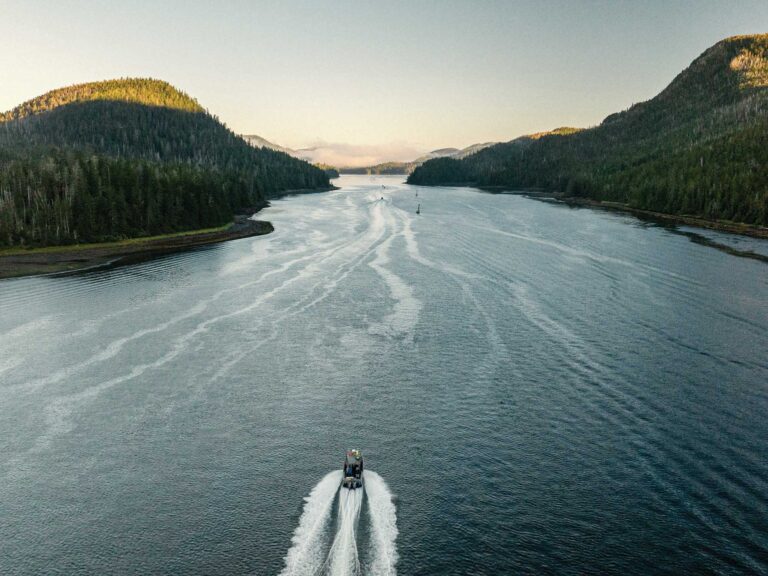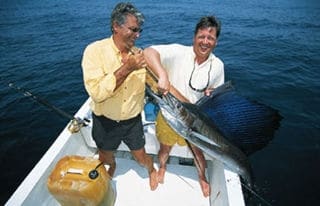
| Kirk Bowles and Stan Lushinsky display a sailfish taken from one of Ixtapa Sportfishing’s well-equipped super pangas. |
They called him The German for his light skin and blue eyes. He was short and cherub-cheeked, with a thin brown mustache that curled above his shy smile. He spoke little English and drove a 25-foot super panga, and he carried with him always a yellow Pok¿mon backpack that contained the tools of his profession: a spool of heavy monofilament, assorted hooks, a small file, a knife, a few chipped and dented lures. How Adolpho Espinosa had come to possess the child’s rucksack is not important, because it was hard to imagine a more appropriate accouterment, and the words inscribed above the joyful, leaping Pikachu emblazoned on its nylon surface could well have served as the guide’s motto: “Got to Catch Them All!”
Kirk Bowles and I first noticed Adolpho’s excellent knapsack on the long run to the roosterfish grounds between Wamaluli Point and Morro de Pampanoa. It gave us confidence, this symbol of fish-catching prowess, and confidence was needed amid the towering swells that were pounding the coast. The rollers collapsed with thunderous force, sending geysers of spray 30 feet high and creating a mist that mingled with the smoke from slash-and-burn farmers in the hills beyond the coastal plain. But it didn’t faze Adolpho, who sat calmly in the stern, chatting with Stan Lushinsky, owner of Ixtapa Sportfishing and our host for the week.
As anticipated, hurling poppers from the bow of a lurching panga while casting nervous glances at the approaching swells proved tricky work, but eventually we got the hang of it. Best of all, the roosters were home, and every so often we would succeed in summoning one from the roiled green water. While we didn’t exactly “catch them all,” by day’s end we had landed five fish – two on poppers and three on bait – and had at least a dozen follows and missed strikes. Not a shabby score for a place that isn’t well known for its inshore fishing.
Billfish Hot Spot
Billfish are the real headliners at Ixtapa-Zihuatanejo – the collective name for two conjoined towns located roughly midway along Mexico’s west coast – and the reason Lushinsky has put so much faith in the area’s potential as asport fishing destination. In recent years he has expanded the scope of available fishing options to include inshore fishing for roosters, jacks, snook, grouper, small tuna and more. Stan first visited Ixtapa-Zihuatanejo (I-Z) in the ’80s, and since then has worked tirelessly to promote the area while putting together a team of top local crews. Additionally, his boats are some of the best in town, ranging from super pangas to luxury cruisers, and he keeps them equipped with quality tackle.
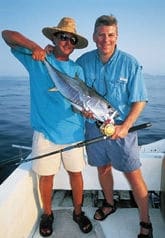
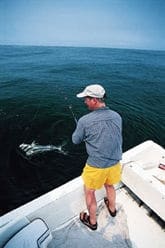
(above) The author, right, and Adolpho “The German” Espinosa pose with a yellowfin trolled up in the early morning. (below) Roosterfish roam the beaches south of I-Z in good numbers. This one was taken on a slow-trolled live bait, but plugs work even better at times.|
Running this show requires a lot of personal attention, and Stan makes five or six trips a year to I-Z, often bringing in fishing and boating gear from the U.S. and making sure the operation is running smoothly. He also spends a good deal of time researching the local fishing scene and experimenting with new techniques. But that’s just fine with Stan, because the guy loves to fish.
Kirk and I learned this on our first day, which saw us heading offshore in search of sailfish and marlin. (“Offshore” is a relative term here, as the action often takes place within five miles of land.) We left the Ixtapa marina at 7:00 a.m. and headed west in El Soltar, a 35-foot Cabo skippered by Captain Miguel Alvarez and crewed by mates Freddy Hernandez and Antonio Farias. A mere 20 minutes later we had lines out and were trolling a spread of skipping baits through the gentle seas.
Calm Seas the Norm
According to Stan, calm conditions and lots of sunshine are the norm off I-Z, except during the September-October rainy season. Furthermore, large swells of the type we experienced along the beach are hardly noticeable offshore. Of course, the lack of wind makes for hot, muggy conditions, and by 10:00 we were beginning to appreciate the Soltar’s air-conditioned salon.
Things got even hotter just before noon, when a trio of sailfish crashed the spread. Working with machine-like precision, Freddy and Antonio expertly baited and hooked each of the sails before passing the rods off to Stan, Kirk and me. By some remarkable stroke of luck we managed to land and release all three fish, the first of many to come.
Sails are by far the main attraction for most visiting anglers, and are available throughout the year (March and April are the slowest months). While you’re not likely to rack up big numbers here, you can expect to raise three to five fish per day, even during the fall rainy season. A six- or seven-sail day is considered very good, but double-digit catches are always a possibility. In fact, Stan’s personal best is 25 sails in a single day.
The primary technique is to troll dead cocineros, a type of small jack, on the surface. If the crew is able to catch a large live bait – usually a black skipjack or bonito (chula) – on the way out, it’s often rigged on a bridle and fished deep off a Z-Wing planer. Stan says that the sails often attack the Z-Wing bait first, then rise to hit the skipping cocineros.
It should be noted that most of the I-Z crews have not yet cottoned to the use of circle hooks, although Stan has made efforts to demonstrate their effectiveness. He points out that visiting anglers can certainly request that circle hooks be used, but should plan on bringing their own. Also, be aware that while catch-and-release is encouraged, the crews will often keep a billfish that appears mortally injured or can’t be revived. These fish are later sold.
Marlin and Tuna, Too
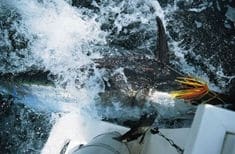
Anglers can generally expect at least one shot a day at marlin from February through May. This 300-pound blue rose to a trolling lure just six miles from shore.|
Blue and black marlin are available off I-Z throughout much of the year (February through May is prime time), and several huge fish have been pulled from the local waters, including a 1,100-pound black taken by Captain Alvarez just a quarter of a mile from shore. That fish was caught on a live skipjack fished off a Z-Wing, but the local crews also troll big artificials if the fish are scattered. In fact, the latter strategy produced a 300-pound blue marlin for Kirk as we were trolling back to the dock on our last day.
Marlin are also caught by trolling live baits and lures around schools of skipjack and yellowfin tuna. The latter species is most abundant through the winter and spring, and fish up to 300 pounds have been caught. During our stay we heard reports of 100-pound tuna being caught to the south of us, but these fish never pushed within range. However, we did manage to land a small yellowfin of around 30 pounds by trolling swimming plugs around a group of craggy, guano-plastered islands known as Rocas Potosi or, more commonly, the White Rocks. These imposing edifices located five miles off Zihuatanejo Bay rise up from 150-foot depths and hold all kinds of game fish. Roosterfish, jacks, snapper and grouper are the normal fare, but wahoo, tuna and sailfish can be caught if blue water pushes in close enough.

(above) The barren Rocas Potosi rise from deep waters and hold everything from cubera snapper to wahoo. (below) Bowles battles a sail from the cockpit of the El Soltar. Note the calm seas, which are the norm in this region.
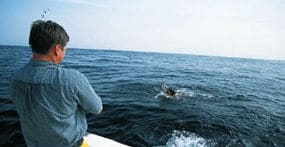
|
We spent some time trolling deep-diving Rapalas around the White Rocks for wahoo, but only managed to nail the aforementioned tuna and a pair of jacks. Later in the trip, Stan and I were able to get in tight to the sheer cliffs and cast plugs into the caves and over submerged ledges. Our efforts mostly produced strikes from a variety of small grouper, snapper and jacks, but Stan also hooked something huge and unstoppable – most likely a cubera or big grouper – that cut him off after diving into the rocks.
Roosters on the Rocks
Roosterfish can also be taken by casting lures and slow-trolling live baits around Rocas Potosi. In fact, these islands produced the biggest rooster ever taken in this area – an 80-pounder. It’s thought that the local roosters stick mostly to the beaches until they reach 50 pounds or so, then move offshore to feed around the islands and rocky points, where larger prey is available. “Giant roosterfish come out to the rocks and wait for a bonito to make a mistake,” says Stan, adding that the way to catch them is to slow-troll a live bait down deep among the rocks. “It’s definitely a game of patience, but it can pay off with a big fish.”
The spot for faster action with roosters is the long, sandy beach 20 to 30 miles southeast of Zihuatanejo, where we fished on our trip. Reaching this area involves a 1 1/2-hour panga ride, primarily because the local guides run slowly to conserve fuel and reduce engine wear, but the trek can be well worth it if you like catching roosters on plugs. One reason this distant beach offers such consistent action is because it’s largely beyond the range of commercial netters from Zihuatanejo. According to Stan, the nets do not kill many roosters, but they remove a lot of the forage and tend to spook the fish.
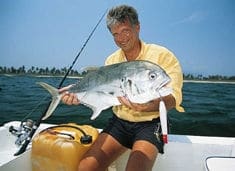
(above) Jacks up to 30 pounds patrol the rocks and beaches, providing fast action on plugs, baits and flies. (below) The El Soltar, one of the top boats in I-Z, docks at the modern Ixtapa Marina, just a short walk from many of the local hotels.
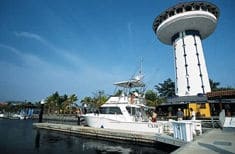
|
The main challenge is finding the roosters, which can be anywhere along a ten-mile stretch of beach. Bird activity, leaping baitfish or breaking fish can sometimes clue you in, but be prepared to do a lot of blind casting or slow-trolling with live baits. Two people can cast comfortably from the panga, but it can be quite a balancing act if a swell is running. Live herring can save the day when the water is roiled by heavy surf, which causes the roosters to move out to deeper structure. But when the fish are tight to the beach, a popper can out-fish live baits ten to one.
Prime roosterfishing in the I-Z area runs May through August, and again from October to December. Last fall, Adolpho reported finding incredible numbers of roosters along the beach, and one day his anglers caught 18 fish! As for the winter months, Stan says that the action is less predictable, although it’s a good time for larger fish.
In addition to roosterfish, you can also expect to encounter some big jack crevalle along the beaches, as well as bonito, black skipjack, houndfish and black snook. The best fishing for snook occurs in late fall, when the flooded lagoons in the region begin to drain, flushing massive amounts of shrimp and baitfish into the ocean. When this happens, snook, roosterfish, jacks and other predators gather around the lagoon entrances to feed. According to Stan, the action can be wild, but is heavily dependent on surf and weatherconditions.
One of the exciting things about the inshore fishing off Ixtapa-Zihuatanejo is that it’s still pretty new. Plus, it adds variety to a week-long trip. For instance, you can fish inshore one day and offshore the next, or even do both in the same day if conditions allow. A real boon to the sport-fishing program here would be a speedy, deep-vee center console equipped with a fuel-efficient four-stroke engine for reaching distant grounds. One can only wonder what a guide like The German would do with such a weapon in his bag of tricks. He might not catch ’em all, but he’d sure have fun trying.
| The I-Z ConnectionZihuatanejo and Ixtapa are two very different neighboring towns located roughly 150 miles northwest of Acapulco on Mexico’s Pacific coast. Zihuatanejo (pronounced “zee-WAH-tan-AY-ho”) is an old fishing town nestled in a protected bay, while Ixtapa, located five miles up the coast, is a modern tourist area replete with bars, dance clubs, numerous restaurants and high-rise hotels that flank the long sand beach. We stayed at the Las Brisas Hotel and the Riviera Beach Resort, known as “the fisherman’s hotel.” Both offer views of the Pacific, excellent service, superb restaurants, clean rooms and accommodating staffs. If you prefer a more laid-back and rustic atmosphere, you may want to check out some of Zihuatanejo’s smaller hotels and guest houses. It’s a great spot to combine fishing with a family vacation.For budget-minded billfisherman, I-Z is a great choice. Not only are accommodations a bargain, especially from April to October, but the charters are a steal, too. Ixtapa Sportfishing’s price for a full day of offshore fishing aboard the air-conditioned 35-foot El Soltar, with two mates, is $650 (food and drink not included). The cost for a full day on a 25-foot super panga equipped with outriggers, live well, rod holders, sun shade, padded bench seats and a mate runs $190. A selection of 28- through 42-foot cruisers in the $275 to $450 price range rounds out the options.Getting to I-Z from the States involves a flight to Mexico City followed by a direct flight to Zihuatanejo. We flew AeroMexico, (800) 237-6639, which provides service from numerous U.S. cities through its affiliation with Mexicana Delta and other members of the Sky Team. Air and lodging packages can be arranged through AeroMexico Vacations by calling (800) 245-8585.For more information on arranging a trip, contact Ixtapa Sportfishing at (570) 688-9466; fax (570) 688-9554; e-mail: ixtsptf@epix.net, or check out their web site at http://www.ixtapasportfishing.com. To obtain an information package and CD on activities, events and accommodations in the I-Z area, contact the Mexico Tourist Board at (212) 821-0304 or go to http://www.ixtapa-zihuatanejo-ocv.com. – Tom Richardson |





